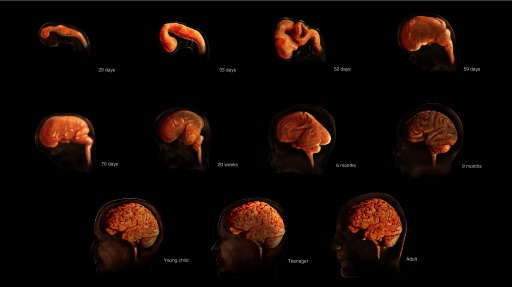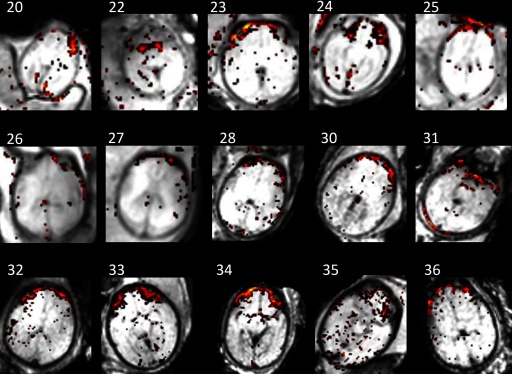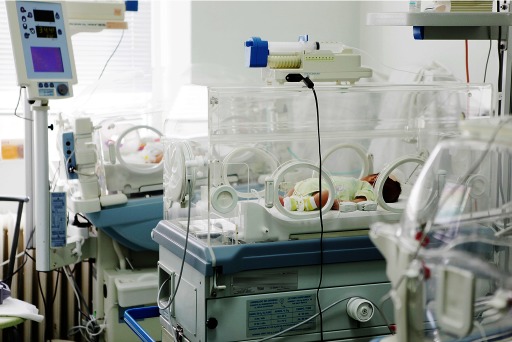From autism to schizophrenia, many brain disorders have long been thought to arise from problems with the connections among nerve cells in the brain.1 Billions of threadlike fibers crisscross the brain, forming labyrinthine networks that relay messages between different brain regions.2 Scientists call this signaling spaghetti the “connectome,”1 and it makes up a blueprint of the trillions of neural connections in the brain.
Some researchers hypothesize that these connections encode essential aspects of personality, behavior, cognition, and memory. As neuroscientist Sebastian Seung subtitled his 2012 book Connectome, our neural wiring makes us who we are.3
In the past decade, advances in a neuroimaging technique called functional magnetic resonance imaging (fMRI) have offered researchers an unprecedented look at how those connections form before and shortly after birth. With these advances, they have also begun to unlock some of the signatures of abnormal brain development.
fMRI is not perfect. The images generated by the technology often must be manipulated to correct for distortion and to scale brain scans to a consistent, comparable template. Movement causes problems with data analysis and interpretation—and babies and fetuses are notoriously wriggly unless asleep or sedated. Finally, technical issues potentially result in artifacts that may not be recognized as errors.4
However, fMRI has also provided a new level of access to the developing brain. In addition, understanding the origins of neurodevelopment—and where brain function goes awry—may provide new insights on the impact of environmental exposures.5 The findings could one day provide avenues for novel neuroprotective strategies.
The process that will ultimately give rise to the connectome begins about 25 days after conception, when the neural tube begins to form. By the end of the embryonic period (gestational week 10), the basics of the neural system are established. All the structures continue to develop throughout the fetal period and early childhood. By 6 years of age, the brain has reached 90% of its adult volume. By age 25, it typically is fully developed. Image: © TheVisualMD/Science Source.
The Black Box of Brain Development
Human brain development starts soon after conception and continues into early adulthood. The fetal brain begins to develop during the third week of gestation. Neural progenitor cells begin to divide and differentiate into neurons and glia, the two cell types that form the basis of the nervous system.6
By the ninth week, the brain appears as a small, smooth structure. Over the course of pregnancy, the structure of the brain will change as it grows and begins to form the characteristic folds that designate distinct brain regions. Changes in brain anatomy reflect dramatic changes at the cellular level. Neurons in the different brain regions begin producing the chemical signaling molecules that will enable communication between nerve cells. The fiber pathways that will become the brain’s information superhighway are forming. The cells that will make up the neocortex—the part of the brain that coordinates sight, sound, spatial reasoning, conscious thought, and language—begin to communicate.6
Although the foundation of a functioning brain is assembled prenatally, brain function itself continues to develop after birth, driven largely by sensory input. The number of neural connections explode in the first years of life—a phenomenon sometimes referred to as a synaptic “big bang.”7 After age 2 years, the number of neural connections decreases. In a process known as synaptic pruning, the brain organizes its connectome to perform more efficiently, removing inefficient connections to maximize performance.
A large body of animal and epidemiological research suggests that prenatal exposures to harmful environmental stimuli, such as maternal stress or toxic agents, may alter the developmental trajectory of the fetal brain.8 However, until recently, prenatal neurodevelopment was a black box.
“We don’t know a lot about what happens in fetal life, because we haven’t had the tools to measure brain development in fetal life,” says Robert Wright, an environmental epidemiologist and pediatrician at the Icahn School of Medicine at Mount Sinai in New York. “It may even differ from [postnatal] development, as the sensory inputs are largely biochemical and passed from mother to child, unlike the direct experience of sound, light, temperature, and movement that a child experiences.”
The developing brain relies on environmental and endogenous stimuli such as these to help it determine which connections should be pruned and which should not. “When a neuron fires after a proper signal, its synaptic connections are solidified,” Wright explains. “If a neuron’s synaptic connection is rarely fired, it regresses and is removed.”
Toxic exposures can interfere with the brain’s ability to distinguish important connections from unimportant ones, altering the development of the connectome. For instance, lead can cause neurons to fire spontaneously in the absence of a proper signal, Wright says. “By inducing neuronal activity inappropriately, [lead] can alter the normal trajectory of synaptic formation and synaptic pruning that underlies the formation of the connectome,” he explains. Ultimately, this type of interference can lead to the development of maladaptive brain signaling networks.
The connectome is shaped by internal and external stimuli throughout the course of life. In the fetus and young child, certain chemical exposures and situational factors (such as maternal stress and low socioeconomic status) are risk factors for neurodevelopmental problems. However, positive influences, such as parental engagement, may help to build resilience and mitigate any negative impacts. Image: © Daniel Atkin/Alamy Stock Photo.
Developing the Tools to Study the Brain in Utero
Most of what scientists know about fetal brain development comes from looking at animal brains or analyzing human postmortem samples.5 This research has provided insights on the development of brain structure but offers few clues about how functional systems become organized.
The earliest investigations of human fetal brain function date back to the 1950s. When researchers placed electrodes on a pregnant woman’s abdomen and on the walls of her cervix during labor, they could detect electrical impulses that signaled fetal brain activity.5 Researchers began to notice that certain patterns of electrical activity were associated with neurological abnormalities.9
In the 1990s, scientists began experimenting with fMRI to map the connections in different regions in the brain.5 fMRI detects changes in brain activity associated with changes in blood flow. During fMRI, the patient typically performs a task—looking at pictures of faces or finger tapping, for instance—while the machine scans his or her brain. Researchers look for areas of the brain that light up during the task.
By that point, neuroscientists knew there was much more happening functionally than could be probed with a stimulus or task, but it was unclear how to best examine these functions. Then, in 1995, then–graduate student Bharat Biswal made a fortuitous observation: The brain produces signals all the time, even when it is not engaged in a task.10 Manipulating fMRI to measure these resting-state signals allowed scientists for the first time to investigate brain activity without the subject needing to so much as tap a finger.
Resting-state fMRI offered a more nuanced look at the highways and interstates connecting different brain regions. These connections form the basis of how different regions of the brain communicate with each other. Whereas investigators previously were limited to studying function within a particular brain region, they could now begin to ask big-picture, network-level questions about brain function.7
In the search for answers about how and when brain networks form, researchers turned to preterm infants.11 Nearly 10% of all babies worldwide are born preterm, meaning before the end of the 37th week of pregnancy.12 Compared with term babies, these children are more likely to develop autism spectrum disorders, attention deficit/hyperactivity disorder, emotional disorders, and neurological abnormalities.13 Preterm infants also are more likely to have cognitive difficulties and trouble in school later on.13 A growing body of research suggests that these cognitive impairments may be caused by disruptions in the way the brain is wired before or shortly after birth.5
Christopher Smyser, a pediatric neurologist at Washington University in St. Louis, Missouri, used fMRI images of preterm infant brains to study prenatal development of the connectome. In 2010, he showed that babies born as early as 26 weeks possessed immature forms of many of the functional brain networks seen in adults.14
These first studies by Smyser and others showed that the brain’s communication channels were present before term birth, albeit in an immature state. Preterm babies offered researchers the opportunity to study the development of neural patterns that usually takes place inside the womb. However, researchers found it difficult to know if the patterns they were seeing in these infants reflected the normal development of brain communication networks. What did functional connectivity look like in a healthy term pregnancy?
Imaging the Fetal Brain
Task-based fMRI had always been a poor option for studying children too young to follow instructions. In utero, it was even less feasible. “You could never know what a fetus was up to, whether it was performing a task or at rest,” says Veronika Schöpf, a professor of neuroimaging at the University of Graz in Austria.
In 2010, Schöpf began using resting-state fMRI to study the brains of fetuses. She ultimately scanned the brains of more than 100 fetuses in their mothers’ wombs.15 It was a tricky task—too much movement on the part of the fetus could blur the picture. In the end, Schöpf had collected functional images of 16 healthy fetuses spanning the 20th to 36th weeks of gestation. Her study was the first to show that resting-state networks were present—and could be detected—in a fetus.
At the time of this study, the chronology for the emergence of the brain’s functional networks was still unknown. However, in a 2014 follow-up study of 32 healthy fetuses, Schöpf et al. showed how the connectome developed over the second half of pregnancy as short- and long-range connections between different brain regions begin to form.16 They found that development of those network connections peaks between about 27 and 30 weeks.
In 2012, Veronika Schöpf et al. captured functional images of fetal brains at gestational weeks 20–36 (the numbers in the figure above indicate gestational week). The team was the first to show that resting-state networks can be detected in utero. This imaging was a major advance over the use of task-based fMRI because, as Schöpf put it, “You could never know what a fetus was up to, whether it was performing a task or at rest.” Image: Schöpf et al. (2012).5
Around the same time, Moriah Thomason, a pediatric neuroscientist at New York University School of Medicine, published the first study to demonstrate age-related changes in fetal brain networks. In a cohort of pregnant Detroit women, she found differences in functional connectivity among 25 healthy fetuses in the second versus the third trimester.17 She also found evidence of synchronized activity between mirror regions in the two hemispheres of the brain. The study showed that this pattern of coordinated activity became stronger with each passing week of pregnancy.
Schöpf’s and Thomason’s early studies offered the first evidence about the timing of functional development in the fetal brain. They also demonstrated that resting-state fMRI may be a helpful tool in identifying and better understanding critical windows of fetal neurodevelopment. With this groundwork laid, investigators now aim to elucidate the origins of neurological disease.
Disentangling the Pre- and Postnatal Environments
In studies of preterm infants conducted after birth, researchers find it difficult to know whether developmental abnormalities arise from the preterm birth itself (e.g., as a result of oxygen deprivation) and the stress of subsequent medical interventions, or if those abnormalities are the result of disease processes that started in the womb. Without that piece of the puzzle, it is impossible to establish whether preterm birth is a symptom or a cause of developmental problems.
The same can be said for most studies of early-life environmental exposures. “If you cannot disentangle the prenatal from the postnatal environment, you cannot get at the genesis of disease,” says Thomason.
Lead exposure is one example. Fetal exposure to lead has been associated with cognitive impairments in childhood.8 However, if lead was present in the mother’s environment during pregnancy, it’s likely to be present in the child’s environment, too (provided the mother and child live together in the home where she resided while pregnant). Therefore, whether an adverse cognitive outcome is a result of something that happened either in fetal life or when the child was 1 or 2 years old is difficult to determine. “Establishing when the effect started might be a clue to understanding if the critical window is fetal life or later in life,” says Wright.
In the case of preterm births, researchers would ideally analyze the brains of preterm infants before birth, but it is often difficult to identify which babies will be born early. However, Thomason has managed to do just that by studying a subset of her cohort of pregnant Detroit women who went on to deliver prematurely. In 2017, Thomason presented the first direct evidence that infants born preterm may be wired differently before birth.18 The fMRI images generated during pregnancy suggested a difference between the brains of preterm versus term babies: An area on the left side of the brain that later forms a language-processing region had weaker connections to other brain regions in fetuses that would be born preterm compared with fetuses carried to term.
Importantly, the was small—just 14 preterm and 18 term pregnancies—and the medical relevance of the findings is not yet clear. Long-term studies are needed to determine whether differences detected in utero predict cognitive impairment later in life, according to Thomason.
The oldest children in Thomason’s Detroit cohort have now reached school age. She is working to link patterns of early brain activity to childhood behavioral outcomes, including speech, motor skills, and cognition. If maps of functional connectivity in the fetal brain turn out to predict health outcomes later in life, the findings will bring us closer to understanding the origins of neurodevelopmental problems.
However, for Thomason, her research is as much about finding the alterable conditions in an environment that could change a child’s developmental trajectory as it is about understanding the genesis of disease. During home visits, she has collected information about each child’s environment. “Fetal brain activity may predict a particular outcome, but what other environmental factors buffer or exacerbate prenatal risk factors?” she asks.
Environmental Health Connections
Other researchers agree that acting on environmental risk factors may be key to developing effective neurobehavioral interventions.4 For preterm infants, interventions could include changing the hospital environment, says Annemarie Stroustrup, a neonatologist at Mount Sinai Hospital in New York.
“The neonatal intensive care unit [NICU] is not designed for environmental health safety,” Stroustrup says. Preterm babies face a host of unfamiliar stressors in the NICU—from bright lights and loud sounds to stressful interventions and potentially toxic chemicals.19 For example, plastic medical equipment may contain hormone-disrupting chemicals, such as phthalates or phenols, and intravenous feeding solutions may contain high levels of neurotoxic metals, such as aluminum. Although such exposures may be largely or wholly tolerable for older patients, their toxicity is amplified in the preterm infant.20
Some developmental abnormalities result from disease processes that started in the womb, but others may arise from the very act of being born prematurely and the stress of subsequent medical interventions. Annemarie Stroustrup et al. are investigating whether the NICU environment contributes to the latter category. If it does, that’s one negative influence that could be changed to a positive—or at least improved. Image: © Nenov/Getty Images.
Stroustrup leads a study designed to look at the developmental impacts of NICU exposures.11 She plans to incorporate the use of neuroimaging to assess neurodevelopment in premature infants under NICU care and then compare early brain connectivity to measures of exposure and childhood behavioral outcomes. “If it turns out that some morbidities are related to environmental exposures in the NICU, that information could be used to improve the NICU environment,” she says.
The brain is plastic, especially during childhood. That means it is able to organize its neural connections in response to its environment—including both positive and negative influences. Although toxic exposures can have a negative influence, other positive influences may help to build resilience and mitigate the negative impacts, Wright says.
“It’s a misconception that if you’re exposed to a certain chemical, you’re destined to get a damaged brain,” he says. “Adverse outcomes are by no means destiny. Positive influences can remold the brain.”
Biography
Lindsey Konkel is a New Jersey–based journalist who reports on science, health, and the environment.
References
- 1.Liao X, Vasilakos AV, He Y. 2017. Small-world human brain networks: perspectives and challenges. Neurosci Biobehav Rev 77:286–300, PMID: 28389343, 10.1016/j.neubiorev.2017.03.018. [DOI] [PubMed] [Google Scholar]
- 2.Pakkenberg B, Gundersen HJ. 1997. Neocortical neuron number in humans: effect of sex and age. J Comp Neurol 384(2):312–320, PMID: 9215725, . [DOI] [PubMed] [Google Scholar]
- 3.Seung S. 2013. Connectome: How the Brain’s Wiring Makes Us Who We Are. New York, NY: Mariner Books. [Google Scholar]
- 4.Smyser CD, Neil JJ. 2015. Use of resting state functional MRI to study brain development and injury in neonates. Semin Perinatol 39(2):130–140, PMID: 25813667, 10.1053/j.semperi.2015.01.006. [DOI] [PMC free article] [PubMed] [Google Scholar]
- 5.Anderson AL, Thomason ME. 2013. Functional plasticity before the cradle: a review of neural functional imaging in the human fetus. Neurosci Biobehav Rev 37(9 Pt B):2220–2232, PMID: 23542738, 10.1016/j.neubiorev.2013.03.013. [DOI] [PubMed] [Google Scholar]
- 6.Stiles J, Jernigan TL. 2010. The basics of brain development. Neuropsychol Rev 20(4):327–348, PMID: 21042938, 10.1007/s11065-010-9148-4. [DOI] [PMC free article] [PubMed] [Google Scholar]
- 7.van den Heuvel MP, Kersbergen KJ, de Reus MA, Keunen K, Kahn RS, Groenendaal F, et al. . 2015. The neonatal connectome during preterm brain development. Cereb Cortex 25(9):3000–3013, PMID: 24833018, 10.1093/cercor/bhu095. [DOI] [PMC free article] [PubMed] [Google Scholar]
- 8.Horton MK, Margolis AE, Tang C, Wright R. 2014. Neuroimaging is a novel tool to understand the impact of environmental chemicals on neurodevelopment. Curr Opin Pediatr 26(2):230–236, PMID: 24535497, 10.1097/MOP.0000000000000074. [DOI] [PMC free article] [PubMed] [Google Scholar]
- 9.Sokol RJ, Rosen MG, Borgstedt AD, Lawrence RA, Steinbrecher M. 1974. Abnormal electrical activity of the fetal brain and seizures of the infant. Am J Dis Child 127(4):477–483, PMID: 4856604, 10.1001/archpedi.1974.02110230023003. [DOI] [PubMed] [Google Scholar]
- 10.Biswal B, Yetkin FZ, Haughton VM, Hyde JS. 1995. Functional connectivity in the motor cortex of resting human brain using echo-planar MRI. Magn Reson Med 34(4):537–541, PMID: 8524021, 10.1002/mrm.1910340409. [DOI] [PubMed] [Google Scholar]
- 11.Stroustrup A, Tetelbaum SL, Aschner JL. 2017. The canary in the coal mine: the value of preterm environmental health cohorts. JAMA Pediatr 171(12):1139.– . [DOI] [PMC free article] [PubMed] [Google Scholar]
- 12.Beck S, Wojdyla D, Say L, Betran AP, Merialdi M, et al. . 2010. The Worldwide Incidence of Preterm Birth. Geneva, Switzerland:World Health Organization; http://www.who.int/reproductivehealth/publications/monitoring/who_bulletin_88.pdf [accessed 14 November 2018]. [DOI] [PMC free article] [PubMed] [Google Scholar]
- 13.Allen M. 2008. Neurodevelopment outcomes of preterm infants. Curr Opin Neurol 21(2):123–128, 10.1097/WCO.0b013e3282f88bb4. [DOI] [PubMed] [Google Scholar]
- 14.Smyser CD, Inder TE, Shimony JS, Hill JE, Degnan AJ, Snyder AZ, et al. . 2010. Longitudinal analysis of neural network development in preterm infants. Cereb Cortex 20(12):2852–2862, PMID: 20237243, 10.1093/cercor/bhq035. [DOI] [PMC free article] [PubMed] [Google Scholar]
- 15.Schöpf V, Kasprian G, Brugger PC, Prayer D. 2012. Watching the fetal brain at ‘rest’. Int J Dev Neurosci 30(1):11–17, PMID: 22044604, 10.1016/j.ijdevneu.2011.10.006. [DOI] [PubMed] [Google Scholar]
- 16.Jakab A, Schwartz E, Kasprian G, Gruber GM, Prayer D, Schöpf V, et al. . 2014. Fetal functional imaging portrays heterogeneous development of emerging human brain networks. Front Hum Neurosci 8:852, PMID: 25374531, 10.3389/fnhum.2014.00852. [DOI] [PMC free article] [PubMed] [Google Scholar]
- 17.Thomason ME, Dassanayake MT, Shen S, Katkuri Y, Alexis M, Anderson AL, et al. . 2013. Cross-hemispheric functional connectivity in the human fetal brain. Sci Transl Med 5(173):173ra24, PMID: 23427244, 10.1126/scitranslmed.3004978. [DOI] [PMC free article] [PubMed] [Google Scholar]
- 18.Thomason M, Scheinost D, Manning JH, Grove LE, Hect J, Marshall N, et al. . 2017. Weaker functional connectivity in the human fetal brain prior to preterm birth. Sci Rep 7:39286, PMID: 28067865, 10.1038/srep39286. [DOI] [PMC free article] [PubMed] [Google Scholar]
- 19.Santos J, Pearce SE, Stroustrup A. 2015. Impact of hospital-based environmental exposures on neurodevelopmental outcomes of preterm infants. Curt Opin Pediatr 27(2):254–260, PMID: 25635585, 10.1097/MOP.0000000000000190. [DOI] [PMC free article] [PubMed] [Google Scholar]
- 20.Bishop NJ, Morley R, Day JP, Lucas A. 1997. Aluminum neurotoxicity in preterm infants receiving intravenous-feeding solutions. N Engl J Med 336(22):1557–1562, PMID: 9164811, 10.1056/NEJM199705293362203. [DOI] [PubMed] [Google Scholar]






